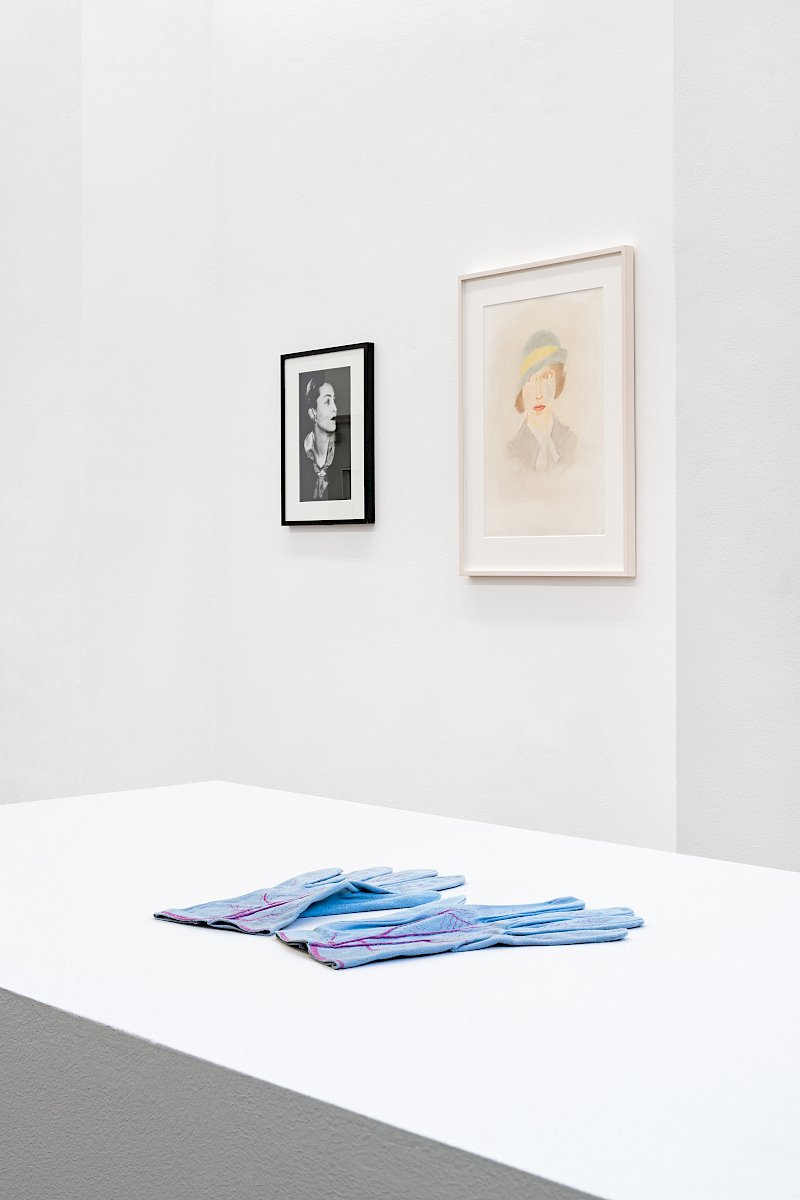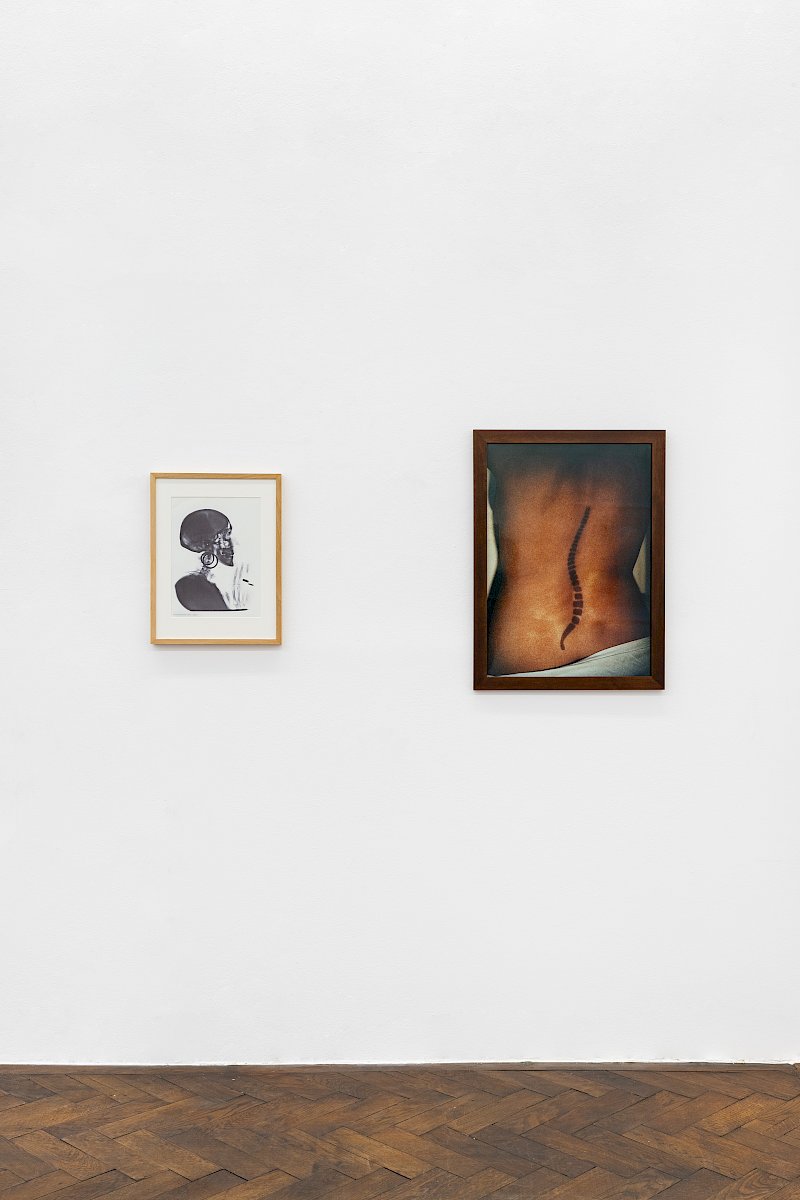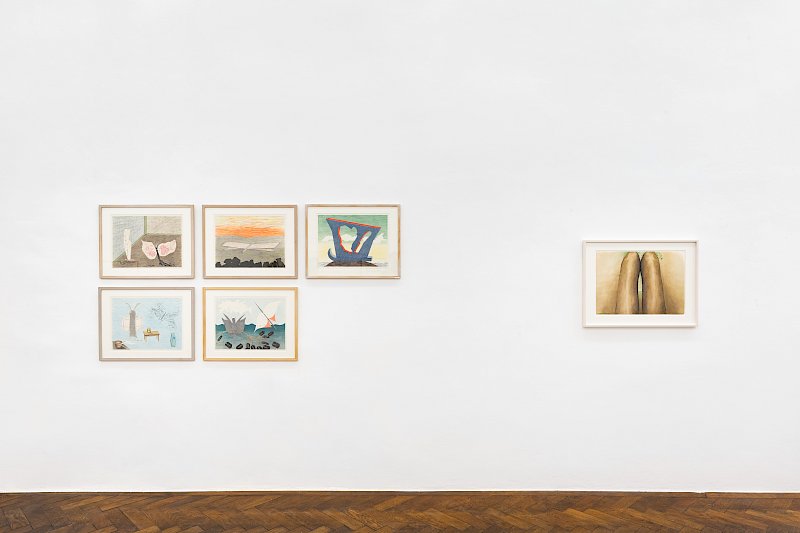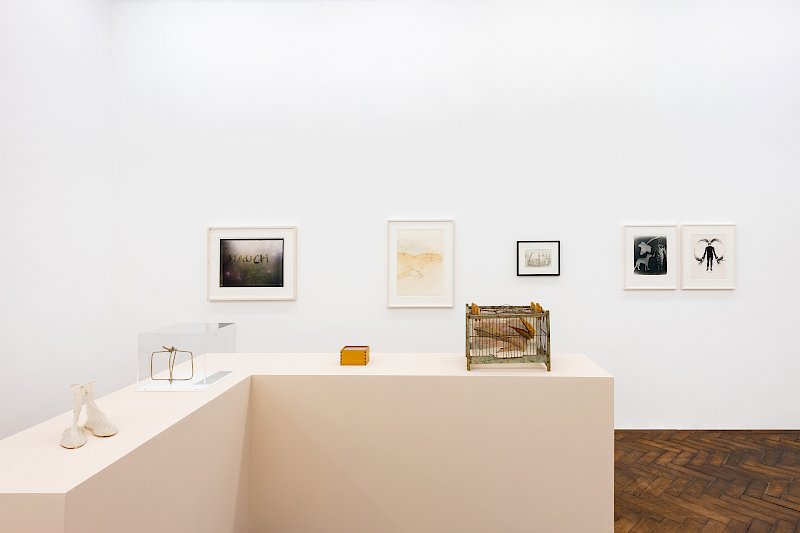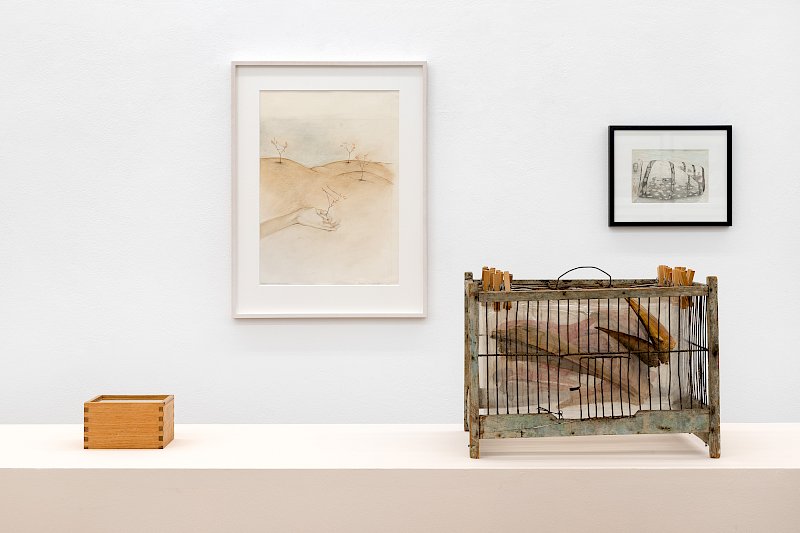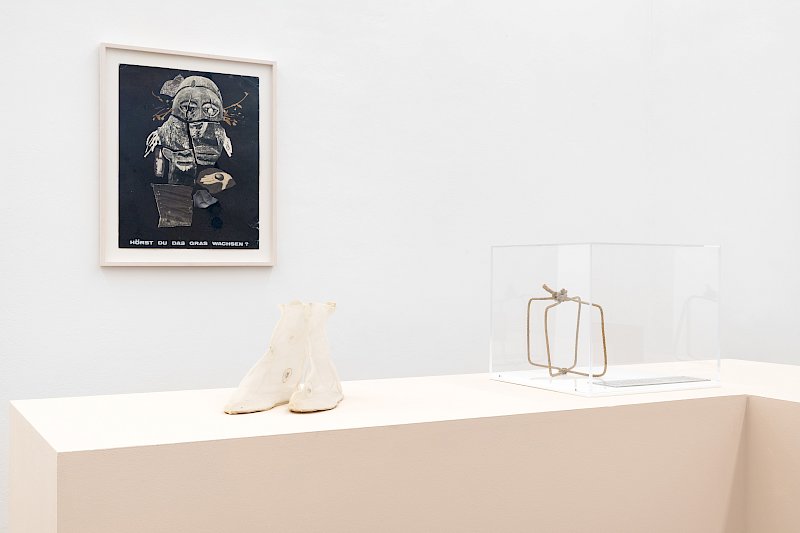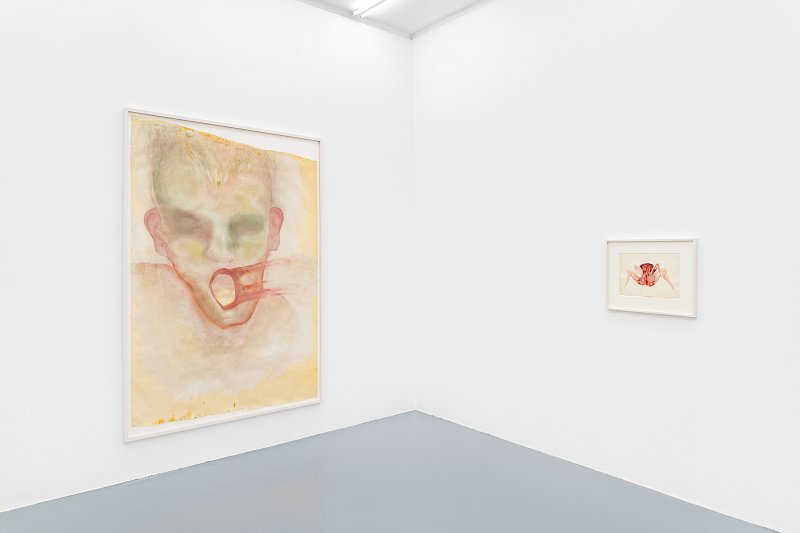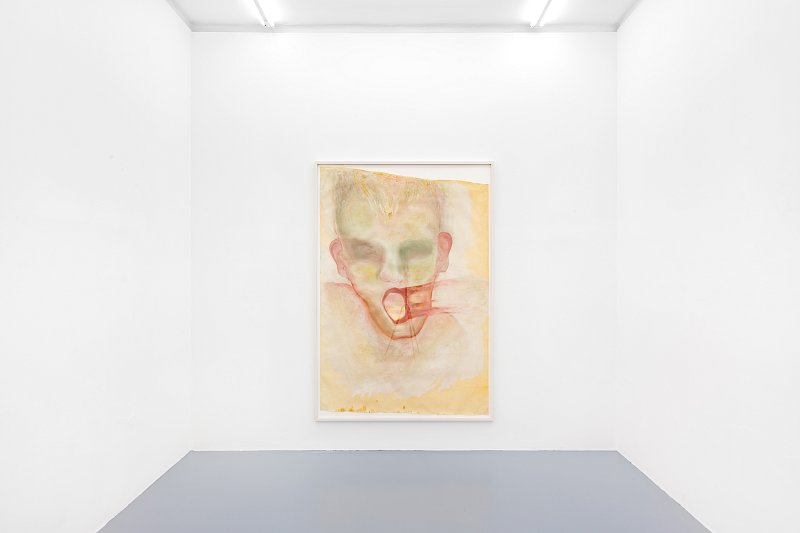The fine fox in the glow of dawn / Spins his web in the glow of dusk / Baneful is the reflection /
Baneful are the additional suns / Without with nothing thrives. (Meret Oppenheim, 1934)[1]
With HÖRST DU DAS GRAS WACHSEN? (CAN YOU HEAR THE GRASS GROW?), Galerie Hubert Winter presents an unprecedented encounter between two pioneering artists of the 20th century: Birgit Jürgenssen (1949-2003) and Meret Oppenheim (1913-1985). The exhibition reflects the joy of experimentation and multidisciplinarity in the emancipatory œuvre of the two artists and highlights their mutual resonances: Stagings in the light of masquerade, disguise and "becoming animal", which ironically undermine the objectification and fetishization of the female body; the subversive and humorous use of language; the examination of the transformation processes of nature, combined with a deep ecological awareness; the fundamental curiosity towards metamorphoses and their transgressive potential.
HÖRST DU DAS GRAS WACHSEN? is the title of an early collage by Birgit Jürgenssen, in which she assembles natural materials and disparate photographic image sources into a strange hybrid being, whereby the individual elements form connections without completely merging into one another. The exposed pictorial seams of the collage, which is thus identified as a construction (the artist herself actively looks out of the eye sockets of the mask), find their formal echo in the formations and fractures of nature—whether as lifelines of the human hand, as folds, cracks, grown ramifications or sediments: everything seems to be related to everything else (a conviction also shared by the American painter Georgia O'Keeffe (1887-1986), who appears twice in the picture).
The artistic strategies of alienation, combinatorics, hybridization and transformation employed here bear witness to Jürgenssen's engagement with French Surrealism, which she discovered for herself early on as "inspirational poetry". In particular, it was Meret Oppenheim, who was artistically socialized in the Surrealist environment in Paris between 1933 and 1936, who was an important figure of identification for Jürgenssen. In 1981, Jürgenssen dedicated the striking staging Selbst mit Fellchen (Self with Little Fur) (1974/1977) to her, in which the fox fur becomes more than just a fashion accessory, but a distinctively adopted part of her own face, thus uncannily questioning the boundaries of the body: "Für Meret Oppenheim in Verehrung. Birgit Jürgenssen" ("For Meret Oppenheim in admiration. Birgit Jürgenssen").
Oppenheim's maxim "Freedom is not something you are given, but something you have to take" was her legacy to an entire generation of subsequent female artists, who appreciated her for her sovereign independence, her transformative identity and her imaginative ability, with which she lent an ironic, commentary-like twist to the surrealist approaches of her colleagues. Against her appropriation as a "feminist" artist, for example in exhibitions dedicated exclusively to women artists such as the exhibition MAGNA. Feminism: Art and Creativity curated by Valie Export in 1975 in the Viennese Galerie nächst St. Stephan, Oppenheim defended herself with what she saw as the fundamental "androgyny of the mind". Carl Gustav Jung's (and to a lesser extent Sigmund Freud's) theories, in particular those on "mental counter-gender", provided the background against which Oppenheim was able to develop androgyny into an emancipatory model with which she questioned notions of standardized gender identity and the corresponding role assignments and mechanisms of power and violence. Enriched by the experiences of the next generation of female artists, in 2002, one year before her death, Jürgenssen answered the question of whether she would describe herself as a feminist artist, "In the sense of becoming aware of, analyzing and deconstructing dominant theories and systems of representation: yes."
Oppenheim's Fur Cup (1936), which was created "for the joy of the paradoxical, the aggressive" and ironically exaggerates the fetishization of fur as a symbol of "animalistic" female sexuality by means of a shock-like pairing with an utility object, became canonical in 1968 at the latest, both at the height of the protest movements and in the year Jürgenssen's collage was created: In the MoMA exhibition Dada, Surrealism, and Their Heritage, where it was presented as the epitome of Surrealist object art (together with her shoe object Ma gouvernante – my nurse – mein Kindermädchen, 1936). What the fur cup was for Meret Oppenheim—a "trademark" that soon became a burden, obscuring the reception of the rest of her oeuvre and which she reproduced in 1970 as a cheap, sentimental kitsch object—was for Birgit Jürgenssen the Schuhwerk (Footwear) in which she used female fetishism as a weapon in continuation of Oppenheim.
Oppenheim's and Jürgenssen's unflinching work on the transitions between supposedly separate spheres—between the human and the non-human, between nature and culture, the organic and the artificial, between dream and reality—consequently also meant defying a homogeneous, recognizable "signature style", media boundaries or conventional art-historical categorizations—a quality that could only be appreciated posthumously in the case of both artists. HÖRST DU DAS GRAS WACHSEN? could be understood in this sense as an appeal to approach our world with heightened sensitivity and attention, to perceive more, to seek out connections or to enter into new relationships that question the boundaries between self and other—an approach that Oppenheim and Jürgenssen pursued even before the term "ecofeminism" was coined in the 1970s and long before "collaboration" and "contamination" were discussed as models of social action and a possible way out of the crisis-ridden state of our contemporary world.[2]
Heike Eipeldauer
[1] Meret Oppenheim, The Loveliest Vowel Empties, translated by Kathleen Heil, New York 2023.
[2] Vgl. Françoise d’Eaubonne, Le Féminisme ou la Mort, Paris 1974; Donna J. Haraway, The Companion Species Manifesto - Dogs, People, and Significant Otherness, Chicago 2003; Anna Lowenhaupt Tsing, Der Pilz am Ende der Welt. Über das Leben in den Ruinen des Kapitalismus, Berlin 2019; Franz Thalmair (Hg.), mixed up with others before we even begin, Exh.-Cat. Museum moderner Kunst Stiftung Ludwig Wien, Cologne 2022; Heike Eipeldauer, Franz Thalmair (Hg.), Kollaborationen, Exh.-Cat. Museum moderner Kunst Stiftung Ludwig Wien, Cologne 2022.



